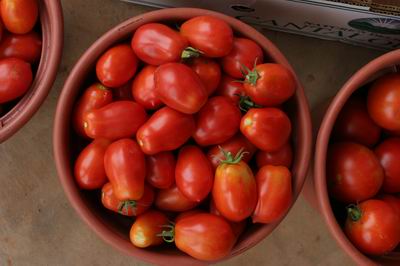|
 The
36 tomato plants we planted in the spring are in full heat-of-the-summer
gear producing an abundance of fruit. We found the following recipe to
freeze fresh tomatoes. We find that the Roma tomatoes work best due to their
fleshy tomato content. We removed the skin on the tomatoes, chopped them up
a bit, bagged them and placed them to the deep freezer. The
36 tomato plants we planted in the spring are in full heat-of-the-summer
gear producing an abundance of fruit. We found the following recipe to
freeze fresh tomatoes. We find that the Roma tomatoes work best due to their
fleshy tomato content. We removed the skin on the tomatoes, chopped them up
a bit, bagged them and placed them to the deep freezer.
YES - It is possible to quickly freeze raw tomatoes without blanching them
first. Frozen tomatoes are best used in cooked foods such as soups, sauces
and stews as they become mushy when they're thawed. We made up a batch of
spaghetti sauce. The tomatoes cooked down to small chunks and the tomato
pulp produced a tomato sauce consistency. The flavor was just like
summer-time tomatoes.
Tomatoes should be washed thoroughly before processing. To remove the skin,
dunk several tomatoes in boiling water for about one minute then place them
in ice water. The skins will just slip off the tomato. Place tomatoes in a
good quality freezer bag, remove all the air before sealing and then freeze.
Tomatoes may be frozen whole, sliced, chopped, or puréed. Additionally, you
can freeze them raw or cooked, as juice or sauce, or prepared in the recipe
of your choice. Thawed raw tomatoes may be used in any cooked-tomato recipe.
Do not try to substituted them for fresh tomatoes, however, since freezing
causes their texture to become mushy. Tomatoes should be seasoned just
before serving rather than before freezing; freezing may either strengthen
or weaken seasonings such as garlic, onion, and herbs.
|
|
The tomato is a herbaceous, usually sprawling plant in the Solanaceae or
nightshade family, as are its close cousins potatoes, chili peppers,
tobacco, eggplant and the poisonous belladonna. It is a perennial, often
grown outdoors in temperate climates as an annual.
The tomato is native to South America. Genetic evidence shows that the
progenitors of tomatoes were herbaceous green plants with small green fruit
with a center of diversity in the highlands of Peru. These early Solanums
diversified into the dozen or so species of tomato recognized today. One
species, Solanum lycopersicum, was transported to Mexico where it was grown
and consumed by prehistoric humans. The exact date of domestication is not
known. Evidence supports the theory the first domesticated tomato was a
little yellow fruit, ancestor of L. cerasiforme, grown by the Aztecs of
Central Mexico who called it xitomatl, meaning plump thing with a navel, and
later called tomatl by other Mesoamerican peoples. Aztec writings mention
tomatoes were prepared with peppers, corn and salt, likely to be the
original salsa recipe.
Many historians believe that the Spanish explorer Cortez may have been the
first to transfer the small yellow tomato to Europe after he captured the
Aztec city of Tenochtítlan, now Mexico City in 1521. Yet others believe
Christopher Columbus, an Italian working for the Spanish monarchy, was the
first European to take back the tomato, earlier in 1493. The earliest
discussion of the tomato in European literature appeared in a herbal written
in 1544 by Pietro Andrea Mattioli, an Italian physician and botanist, who
named it pomo d’oro, golden apple.
The word tomato comes from a word in the Nahuatl language, tomatl. The
specific name, lycopersicum, means "wolf-peach". - wikipedia
|
What What What Recipe Box
© REED Technologies |